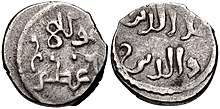Muhammad III of Alamut
ʿAlāʾ ad-Dīn Muḥammad III (1211–1255), son of Jalāl al-Dīn Ḥassan III, was the 26th Nizāri Ismāʿilī Imām. He ruled from 1221-55.[1] His reign witnessed the beginnings of the Mongol devastations of Persia and the eastern Muslim world, and he tried unsuccessfully to establish friendly ties with the Mongols and to prevent their destruction of the Nizari Ismaili state, which was already underway.[2]

He was succeeded by his eldest son Rukn al-Din Khurshah in 1255.[2]
Life

He was the only surviving son of Jalaluddin Hasan,[3] whom he succeeded at the age of 9 years old,[4] in 1221.[5] However, upon succession he was initially too young, so Ḥassan III's vizier controlled the state.[6] His mother was a Sunni woman[7] and a daughter of one of the princes of Gilan.[8][7]
Alauddin Muhammad or Muhammad III was born in 609/1213. He was succeeded by his father at the age of 9 years. The administration of the state affairs had been governed by his gifted mother for about six years, which was the first instance when a woman administered at Alamut. The period of six years (618/1221 to 624/1227) was very peaceful in Alamut, during which time the Imam's mother seems to have deposed many incapable governors in Rudhbar and Kohistan. It seems that some governors and officers had misused their powers in that period. In 624/1227, Alauddin Muhammad took the power upon the death of his mother at the age of 15 or 16 years and dealt iron-handed with the persons misusing the powers. Most of them turned against him and went to live in Qazvin. In order to cover the story of their defalcations, they started to spread rumors against the Imam in bitter sarcasm. Some of them went on to propagate that the brain of Alauddin Muhammad had been affected a few months before 624/1227 when a physician operated him, causing waste of excess blood. The oppositions were however surmounted very soon. Under Muhammad III's reign, the Sunni conformity initiated by his father was gradually and quietly reversed[9] and his community increasingly regarded itself openly as Ismaili Shi'ite.[4][10]
His rule was described as "cruel, imperious, sadistic, alcoholic, and unpredictable."[11]
The Mongol invasions of Nizari strongholds in Quhistan in 1253 and the imminent arrival of Hülegü's army in 1255 incited internal conflicts upon Nizaris. The relationship of Muhammad, who had reportedly been afflicted by melancholia and mental deterioration, was deteriorated with his advisors and Nizari leaders, as well as his son Rukn al-Din Khurshah, who was supposed to be the future Imam. According to Persian historians, the Nizari elites prepared a plan against Muhammad to replace him with Khurshah, who would then enter into immediate negotiations with the Mongols; however, Khurshah fell ill before implementing this plan. Soon afterward, on 1 December 1255, Muhammad was murdered in suspicious circumstances in Shirkuh near Alamut and was succeeded by Khurshah.[12][13] The murderer was later found to be Muhammad's companion Hasan Mazandarani, as revealed by his wife. Mazandarani and three of his children were later executed by Khurshah, as retribution.[13][14][15]
See also
- List of Ismaili imams
- Fatimids
- Isma'ilism
- Nizari
- Aga Khan
References
- Meriem Pages (2007). The Image of the Assassins in Medieval European Texts. ProQuest. p. 25. ISBN 9780549171683.
- Farhad Daftary (15 May 1994). The Assassin Legends: Myths of the Isma'ilis (illustrated, reprint ed.). I.B.Tauris. p. 43. ISBN 9781850437055.
- Jestice, Phyllis G., ed. (2004). Holy People of the World: A Cross-cultural Encyclopedia, Volume 1 (illustrated ed.). ABC-CLIO. p. 421. ISBN 9781576073551.
- Jestice, Phyllis G., ed. (2004). Holy People of the World: A Cross-cultural Encyclopedia, Volume 1 (illustrated ed.). ABC-CLIO. p. 349. ISBN 9781576073551.
- The Muslim Review, Volumes 3-4. University of Minnesota. 1928. p. 17.
- W B Bartlett (1 May 2013). "Nemesis". Assassins: The Story of Medieval Islam's Secret Sect. The History Press. ISBN 9780752496146.
Hasan's vizier took control of the government at Alamut till Muhammad should be old enough to take over from him.
- James Wasserman (1 Apr 2001). The Templars and the Assassins: The Militia of Heaven. Inner Traditions / Bear & Co. p. 123. ISBN 9781594778735.
- Delia Cortese; Simonetta Calderini (2006). Women and the Fatimids in the World of Islam (illustrated, reprint ed.). Edinburgh University Press. pp. 61–2. ISBN 9780748617333.
- Farhad Daftary (2012). Historical Dictionary of the Ismailis (illustrated ed.). Scarecrow Press. p. liv. ISBN 9780810861640.
- Daryoush Mohammad Poor (18 Sep 2014). Authority Without Territory: The Aga Khan Development Network and the Ismaili Imamate. Palgrave Macmillan. p. 234. ISBN 9781137428806.
- James Wasserman (1 Apr 2001). The Templars and the Assassins: The Militia of Heaven. Inner Traditions / Bear & Co. pp. 124–5. ISBN 9781594778735.
- Willey, Peter (2005). Eagle's Nest: Ismaili Castles in Iran and Syria. Bloomsbury Academic. pp. 75–85. ISBN 978-1-85043-464-1.
- Daftary, Farhad (1992). The Isma'ilis: Their History and Doctrines. Cambridge University Press. p. 422. ISBN 978-0-521-42974-0.
- David Hatcher Childress (2003). Pirates and the Lost Templar Fleet: The Secret Naval War Between the Knights Templar and the Vatican (illustrated ed.). Adventures Unlimited Press. p. 95. ISBN 9781931882187.
- James Wasserman (1 Apr 2001). The Templars and the Assassins: The Militia of Heaven. Inner Traditions / Bear & Co. p. 126. ISBN 9781594778735.
External links
‘Alā’ ad-Dīn Muḥammad III of the Ahl al-Bayt Clan of the Banu Quraish Born: 1211 C.E Died: 1255 C.E. | ||
| Regnal titles | ||
|---|---|---|
| Preceded by Jalālu-d-Dīn Ḥassan III |
7th Ruler of Nizārī Ismā'īlī state and Commander of Alamut Castle 1221–1255 |
Succeeded by Rukn-ud-Dīn Khurshāh |
| Shia Islam titles | ||
| Preceded by Jalālu-d-Dīn Ḥassan III |
Imām ‘Alā’ ad-Dīn Muḥammad III 26th Imām of Nizārī Ismā'īlīs 1221–1255 |
Succeeded by Rukn-ud-Dīn Khurshāh |
